In the vast pool of pressing equipment, the cable machine comes to the forefront as a versatile tool. While barbells, dumbbells, and other free weights are the main equipment selected in many chest-training routines, cable machines can also be used. Cable machines provide an alternative with a ton of versatility (in terms of exercise variation and body parts) and an increased opportunity for muscle isolation. And one of the areas that they are quite efficient in working is, you guessed it— the chest.
So – let us take you through five of our favorite cable exercises to help you target your upper, middle, and lower chest. We’ll show you how to do the cable chest press, the flat cable chest fly, the low-to-high cable chest fly, the cable crossover, and the low-to-high cable crossover. We will also detail the benefits of working out with a cable machine and share some pro tips on how to best use one.
What are the Best Cable Chest Workout Exercises?
Here are the most effective cable chest workout:
- Cable Chest Press: 3-5 sets of 6 to 10 repetitions.
- Cable Crossover: 2 to 4 sets of 10 to 15 repetitions.
- High-to-Low Cable Crossover: 2 to 4 sets of 10 to 15 repetitions.
- Flat Cable Chest Fly: 2 to 4 sets of 10 to 15 repetitions.
- Low-to-high Cable Chest Fly: 2 to 4 sets of 10 to 15 repetitions.
We’ve provided a good mix of compound and isolation exercises that will allow you to work both on your strength and muscle hypertrophy. These exercises don’t all have to be done on the same day but can be incorporated into your upper-body days based on your goals and preferences. We’ll also go through which muscles each exercise focuses on, so that you can choose what and when to integrate into your workouts.
1. Cable Chest Press
The cable chest press is a compound movement that serves as a great alternative to the standard barbell bench press. Much like the latter, the cable chest press activates the pectorals, anterior deltoid, and triceps, but it also works other muscles of the shoulder girdle including those making up the rotator cuff.
The cable chest press can be done both in the sitting and standing positions. Which variation you choose could depend on what muscles you want to focus on, as the seated cable press usually activates the upper chest more, while the standing variation encourages more core activation and back activation, as it demands more attention to posture. Despite this, the results will mostly be similar, so a trainee could technically choose from the two based on their personal preferences. [1]
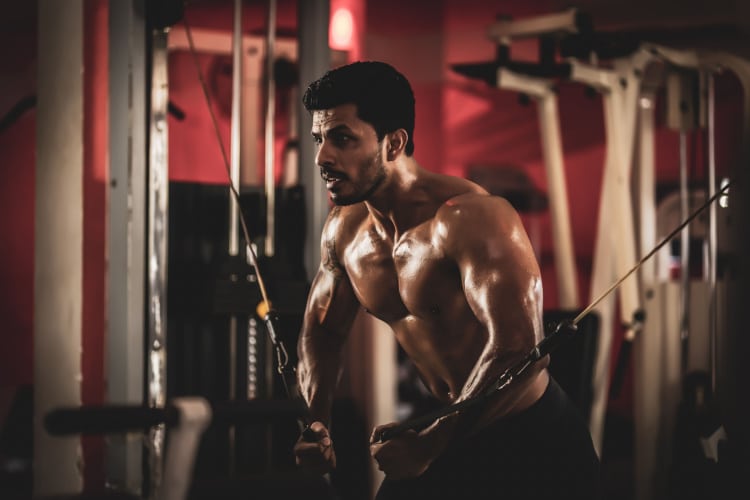
Movement Category: Primary
Programming: 3-5 sets of 6 to 10 repetitions.
Weight: Use a weight that leaves you 2 to 3 reps short of failure, e.g. RPE 7 to 8.
To do a cable chest press:
- Set the pulleys to shoulder height.
- Hold a handle in each hand in an overhand grip, then stand between the cables with your back turned towards the equipment.
- Position your feet slightly wider than shoulder-width apart and take a step forward. Your front knee should be slightly bent.
- Lift your arms and bend the elbows 90 degrees. Your elbows and forearms should be in line with the resistance line. This is your starting position.
- Take a deep breath and hold it for a second. Engage your core to keep your spine stable.
- On the exhale, press your arms forward. Your thumbs should connect at the center – this is the finishing position.
- Inhale as you return your arms to the starting position. All movements should be done slowly and with as much control as possible.
2. Flat Cable Chest Fly
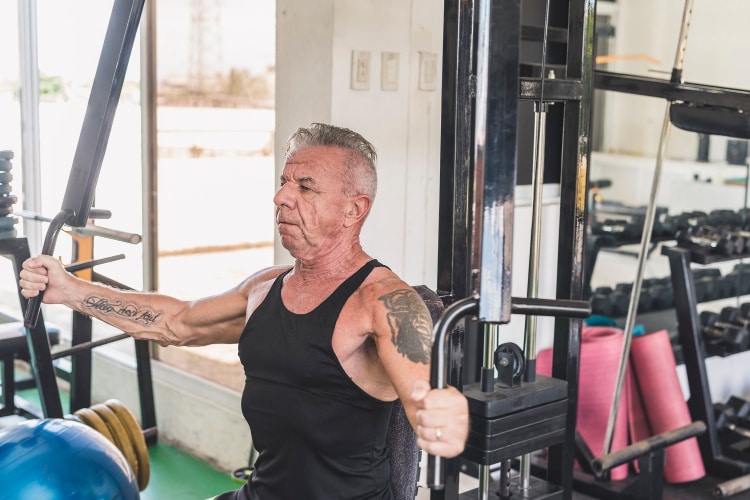
The flat cable chest fly is an isolation movement that seems to increase muscle excitation in the sternocostal head of the chest, offering a targeted approach to enhancing pectoral muscle development. It’s a great alternative to the dumbbell fly.
This exercise is great for inducing muscle hypertrophy, as the force-curve created by the cams and pulleys of the cable machine offer a different challenge for the muscles than free weights. For some, this may produce greater muscle hypertrophy than free weights. [2]
The flat cable chest fly requires a full range of motion that should be completed with control and precision, giving trainees a great opportunity to achieve muscle hypertrophy, as training at longer muscle lengths tends to increase hypertrophy responses. [5]
Movement Category: Tertiary
Programming: 2 to 4 sets of 10 to 15 repetitions.
Weight Use a weight that leaves you 1 to 2 reps short of failure, e.g. RPE 8 to 9.
To do a flat cable chest fly:
- Position a flat bench between the two pulleys of a cable machine.
- Lower the pulleys to a position low enough so that the handles line up with your chest as you lie down on the bench.
- While lying down, keep your feet planted on the floor and grab onto the handles with a supinated grip.
- Extend your arms out to the sides with your elbows slightly bent. Your forearms should be parallel to the ground. This is your starting position.
- Take a breath and on the exhale, slowly pull the cables up in a semicircular motion, until your thumbs connect at the top.
- Inhale as you slowly release your arms back to the starting position. Execute all movements with as much control as possible.
3. Low-to-High Cable Chest Fly
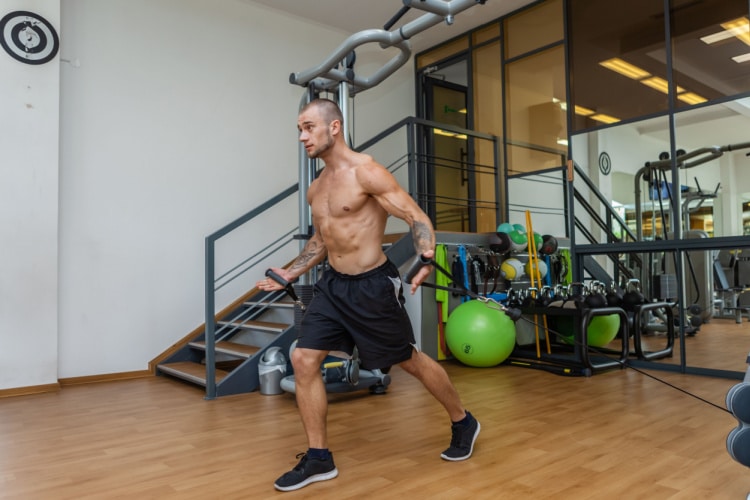
This exercise will literally take the standard cable fly to new heights. The low-to-high cable fly is an isolation movement, meaning that only a single joint is moving, in this case the shoulder joint. Still, it works multiple muscles like the clavicular head of the pectoralis major, anterior deltoid, and serratus anterior as stabilizers.
Although we’ll go through exercises for lower-chest activation, keep in mind that turning this exercise on its head – i.e. performing a high-to-low variation – will activate the lower chest, instead. In essence, the heights of the pulleys can be adjusted according to what you’d like to achieve with the exercise.
Movement Category: Tertiary
Programming: 2 to 4 sets of 10 to 15 repetitions.
Weight Use a weight that leaves you 1 to 2 reps short of failure, e.g. RPE 8 to 9.
To do a low-to-high cable chest fly:
- Set both pulleys at around waist level (or lower for more tension).
- Grab both handles with your hands facing up, your arms lowered to the sides, and a slight bend at your elbows. Your arms should form a 45-degree angle with your body from the shoulder joint.
- Stand with your feet slightly wider than shoulder-width apart and take a big step forward with one leg. Your front leg should be slightly bent at the knee.
- Keep your chest high, back straight, and core tight. This is your starting position.
- Take a deep breath and on the exhale, slowly pull your arms up to chest level. Your hand should connect at the center at the top.
- While inhaling, slowly lower your arms back to the starting position. All movements should be done with as much control as possible.
4. Cable Crossover
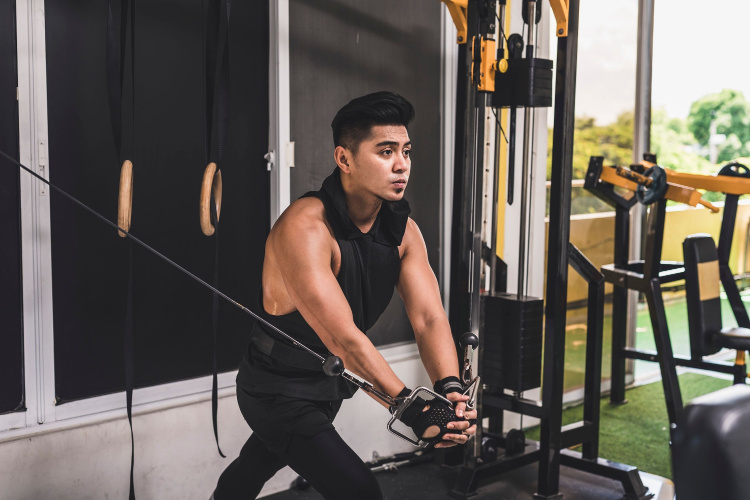
The cable crossover is another isolation exercise that can do wonders for building muscle across the entire pectorals. It’s a fan favorite among many fitness enthusiasts and for a good reason. Through a long range of motion, it encourages deep pectoral contraction when you cross your wrists over one another at the end range of motion. The crossover action could serve for better activation of the pectoralis major and the serratus anterior, due to the additional humeral abduction.
Similar to the cable fly, the cable crossover could be performed at different angles to induce different effects, but more on that later.
Movement Category: Tertiary
Programming: 2 to 4 sets of 10 to 15 repetitions.
Weight Use a weight that leaves you 1 to 2 reps short of failure, e.g. RPE 8 to 9.
To do a cable crossover:
- Adjust the pulleys to shoulder height.
- Grab onto the handles with an overhand grip.
- Stand with your feet slightly wider than shoulder-width apart and take a big step forward with one leg. Your front leg should be slightly bent at the knee.
- Raise your arms and bend your elbows 90 degrees. Your forearms should be parallel to the ground.
- Keep your chest high, back straight, and core tight. This is your starting position.
- Inhale, and on the exhale press your arms forward until your wrists cross over one another at the center.
- Inhale as you slowly draw your arms back to the starting position with as much control as possible.
- Alternate which wrist is at the top with each repetition.
5. Low-to-High Cable Crossover
The low-to-high cable crossover is a cable crossover variation that may put more of the load on the clavicular head of the pectoralis major. It also recruits the anterior deltoid and biceps brachii. They mimic the line of pull of the clavicular head, so they’re a great isolation exercise to train the upper pectorals. Similar to the standard cable crossover, the added range of motion allows the upper middle pectorals to clench, thus training the chest more efficiently.
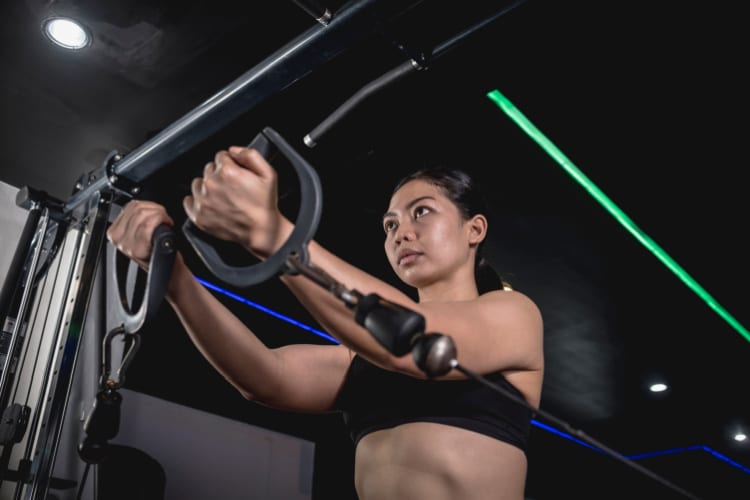
Movement Category: Tertiary
Programming: 2 to 4 sets of 10 to 15 repetitions.
Weight Use a weight that leaves you 1 to 2 reps short of failure, e.g. RPE 8 to 9.
To do a high-to-low cable crossover:
- Adjust the pulleys to head level (or to the highest position for added tension).
- Grab onto the handles with your palms facing down.
- Keep your legs shoulder-width apart and take a step forward with one foot. The front leg should be slightly bent at the knee.
- Keep your elbows slightly bent at their highest position. Pull your shoulder blades together. This is your starting position.
- Take a breath and on the exhale, pull the cables down in an arc motion and let your wrists cross over one another at the lowest point in the center.
- Hold this position for a second, then on the inhale slowly raise your arms back to the starting position. Do this with as much control as possible and alternative which wrist is on top with every rep.
Throughout these exercises, keep your core tight and your spine as straight as possible. Remember to breathe out as you press and inhale as you return to the starting position. Don’t feel alarmed if you feel the exercises in your shoulders as well, as most cable machine chest exercises engage the deltoids along with the pectorals. [6]
What are the Benefits of Working Out With a Cable Machine?
Now, you still may be wondering why you should use a cable machine when there are weights lying around. And indeed – versions of these exercises can be done with a bar or dumbbells, and cable machines may not always be available. However, there’s a reason why cable machines are so popular with trainees. Here are some of them:
Cable Machines Are Versatile
Cable machines offer many different ways in which you can train your chest, shoulders, arms, and back. Specifically, because both the height of the handles can be adjusted and the lifter can change the position of the arms and body relatively freely, cable machines allow an individual to do exercises like presses and flyes at many different angles compared to free weights. Lastly, some types of cable exercises can produce a larger range of motion than free weights, which may help in building more size. [3, 4]
Cable Machines Are Great for Isolation Movements
While it is possible to isolate different muscles using free weights, cable machines provide a potentially easier alternative to do that. Free weights generally necessitate a lot more stability and control to achieve isolation due to their almost infinite degrees of freedom.
Cable machines, on the other hand, are much more straightforward. By simply adjusting the pulleys, trainees could successfully isolate the upper, middle, and lower parts of the pectorals. This is especially great for beginners who are trying to learn the correct range of motion or work on their mind-muscle coordination. For more advanced lifters, it could also provide the benefit of helping muscles adjust to a movement that will be done with free weights later on.
Tips for Working Out With a Cable Machine
Just like any other workout equipment, there are certain things you should know about the cable machine in order to get the most out of your exercise and reap the most benefits.
Familiarize Yourself With the Machine
While it’s quite simple to use once you get the hang of it, the cable machine may seem much more complicated than free weights to the unfamiliar eye. This is why it’s important to learn about the machine, its parts, and how to use it.
If you’ve never used a cable machine before, ask your gym’s trainer to give you a rundown of how they work. Setting up the machine could be complicated, so make sure you fully understand how it’s done before you try it. And remember to never move the pin in the middle of an exercise, as this could damage the machine or result in injury.
Make Room for Movement
Some cable machines use a larger range of motion than their free-weight counterparts, and this may require more space.. For standing cable exercises, make sure that your step is big enough to experience the full benefits. It’s also important to make sure you’ve got enough space for your arms to go through the full range of motion required by the exercise.
Focus on Control
If there isn’t enough force to push against the resistance, the cable machine handles will snap back with the weight. This is why it’s important, especially while returning to the starting positions of exercises, to move slowly, with as much control as possible. Slow and controlled movements will not only encourage you to follow your range of motion appropriately and keep the correct posture but will also allow you to maximize the benefits that come with a constant load.
Train With Barbell Medicine
Our last tip is: train with professionals. Not only would a professional trainer lead you through the ins and outs of using a cable machine, but they would also tailor-make a training program for you, monitor your progress, and tell you how to work out most effectively and efficiently.
Personal training is one of the things we do best at Barbell Medicine. Our staff of licensed coaches, physicians, and dietitians will create a program tailored to your needs and goals and keep you motivated throughout your training journey. Our experience, strong work ethic, and reliance on the latest findings in the field of sports science allow us to help you elevate your health and fitness with strictly scientific and medical methods.
Interested?
If you’d like to train with Barbell Medicine, reach out to us to get a personalized fitness program delivered right to your inbox. We welcome the opportunity to learn more about your individual training goals and expectations and help you achieve them.
Beyond personal trainers, if you prefer to train alone, we offer a wide selection of training templates aimed at different fitness levels and trainees with different objectives. You’ll certainly find one that works for you!
Conclusion
The cable machine is a great piece of equipment that can add a lot of variety to your training. It’s especially great for trainees looking to build strength and muscle mass in their chest, as it can be used to do a wide range of both compound and isolation exercises. And the best part is, unlike with free weights, you don’t need a spotter for cable machine exercises.
Here’s a reminder of our favorite cable chest exercises:
- Cable Chest Press
- Cable Crossover
- High-to-Low Cable Crossover
- Flat Cable Chest Fly
- Low-to-high Cable Chest Fly
With a little attention to detail and control, the cable machine could become one of the most beneficial pieces of equipment for effective chest exercises.
References:
- Muyor, J. M., Rodríguez-Ridao, D., & Oliva-Lozano, J. M. (2023). Comparison of Muscle Activity between the Horizontal Bench Press and the Seated Chest Press Exercises Using Several Grips. Journal of Human Kinetics, 87, 23–34. https://doi.org/10.5114/jhk/161468
- Signorile, J. F., Rendos, N. K., Heredia Vargas, H. H., Alipio, T. C., Regis, R. C., Eltoukhy, M. M., Nargund, R. S., & Romero, M. A. (2017). Differences in Muscle Activation and Kinematics Between Cable-Based and Selectorized Weight Training. Journal of strength and conditioning research, 31(2), 313–322. https://doi.org/10.1519/JSC.0000000000001493
- Signorile, J. F., Rendos, N. K., Heredia Vargas, H. H., Alipio, T. C., Regis, R. C., Eltoukhy, M. M., Nargund, R. S., & Romero, M. A. (2017). Differences in Muscle Activation and Kinematics Between Cable-Based and Selectorized Weight Training. Journal of strength and conditioning research, 31(2), 313–322. https://doi.org/10.1519/JSC.0000000000001493
- Richardson, Mark & Rendos, Nicole & Eltoukhy, Moataz & Signorile, Joseph. (2016). Comparative Impacts of Plate-Loaded and Cable Resistance Machines on Muscle Activity and Joint Kinematics: 1690 Board #343. American College of Sports Medicine Annual Meeting. 48. S364. 10.1249/01.mss.0000486415.96212.ec.
- Pallarés, Jesús G et al. “Effects of range of motion on resistance training adaptations: A systematic review and meta-analysis.” Scandinavian journal of medicine & science in sports vol. 31,10 (2021): 1866-1881. doi:10.1111/sms.14006
- Signorile, J. F., Rendos, N. K., Heredia Vargas, H. H., Alipio, T. C., Regis, R. C., Eltoukhy, M. M., Nargund, R. S., & Romero, M. A. (2017). Differences in Muscle Activation and Kinematics Between Cable-Based and Selectorized Weight Training. Journal of strength and conditioning research, 31(2), 313–322. https://doi.org/10.1519/JSC.0000000000001493